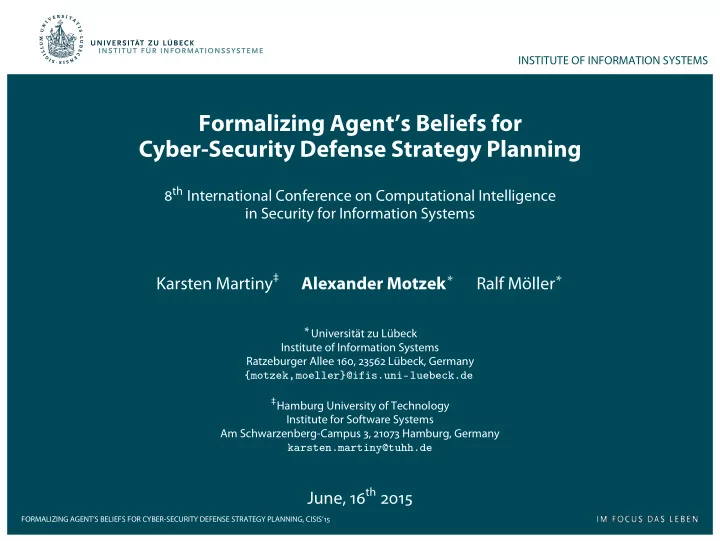

INSTITUTE OF INFORMATION SYSTEMS Formalizing Agent’s Beliefs for Cyber-Security Defense Strategy Planning 8 th International Conference on Computational Intelligence in Security for Information Systems Karsten Martiny ‡ Alexander Motzek ❻ Ralf Möller ❻ ❻ Universität zu Lübeck Institute of Information Systems Ratzeburger Allee 160, 23562 Lübeck, Germany {motzek,moeller}@ifis.uni-luebeck.de ‡ Hamburg University of Technology Institute for Software Systems Am Schwarzenberg-Campus 3, 21073 Hamburg, Germany karsten.martiny@tuhh.de June, 16 th 2015 FORMALIZING AGENT’S BELIEFS FOR CYBER-SECURITY DEFENSE STRATEGY PLANNING, CISIS’15
INSTITUTE OF INFORMATION SYSTEMS Introduction ▲ Proactive measures sometimes not possible. e.g. proactive removal of known vulnerabilities Critical infrastructure remains exposed. � Reactive strategies at a last stage of an attack. � maintain a model of an intruder’s belief state formalized using Probabilistic Doxastic Temporal ( PDT ) Logic. FORMALIZING AGENT’S BELIEFS FOR CYBER-SECURITY DEFENSE STRATEGY PLANNING, CISIS’15
INSTITUTE OF INFORMATION SYSTEMS Considerations and Assumptions ▲ We start at a last point of defense . ▲ Highly skilled attacker with extensive knowledge about our network. ▲ Two stages of an attack. - Stage of escalated privileges (‘‘Shell’’). - Code execution of (handcrafted) malware (‘‘Exec’’). FORMALIZING AGENT’S BELIEFS FOR CYBER-SECURITY DEFENSE STRATEGY PLANNING, CISIS’15
INSTITUTE OF INFORMATION SYSTEMS Shell ▲ ‘‘From stock’’ ▲ Obtained through (standard, known ) patterns . ▲ Can be detected through an IDS: Obs D ❼ attack ❼ X ➁➁ . ▲ Does not expose attacker’s identity. � Can be defended() . OR � If monitored , can allow observation of executed code. FORMALIZING AGENT’S BELIEFS FOR CYBER-SECURITY DEFENSE STRATEGY PLANNING, CISIS’15
INSTITUTE OF INFORMATION SYSTEMS Code execution ▲ Will be handcrafted . ▲ Might allow identification of attacker. ▲ Might reveal intention of attack. ▲ Can seriously harm our system. ▲ If not immediately observed, no traces left. � So we should always defend? but FORMALIZING AGENT’S BELIEFS FOR CYBER-SECURITY DEFENSE STRATEGY PLANNING, CISIS’15
INSTITUTE OF INFORMATION SYSTEMS Always defend? ▲ No. No IDS is perfect. ▲ Would perfectly tell the attacker if she is undetected . ▲ Defense might be dangerous as well. FORMALIZING AGENT’S BELIEFS FOR CYBER-SECURITY DEFENSE STRATEGY PLANNING, CISIS’15
INSTITUTE OF INFORMATION SYSTEMS Minimal Example - Introduction ▲ We have two devices. ▲ Productive system and Backup system. ▲ Backup can be sacrificed . ▲ Only defend productive? FORMALIZING AGENT’S BELIEFS FOR CYBER-SECURITY DEFENSE STRATEGY PLANNING, CISIS’15
INSTITUTE OF INFORMATION SYSTEMS Minimal Example - Introduction ▲ We have two devices. ▲ Productive system and Backup system. ▲ Backup can be sacrificed . ▲ Only defend productive? No . We perfectly tell her which device to attack. FORMALIZING AGENT’S BELIEFS FOR CYBER-SECURITY DEFENSE STRATEGY PLANNING, CISIS’15
INSTITUTE OF INFORMATION SYSTEMS We can belief... ▲ At every timestep one attack (maybe). ▲ Observe nothing at t � missed an attack at t or at t ✏ 1. ▲ Observe attack at t , � missed a previous attack at t ✏ 1. � We consider multiple worlds possible. FORMALIZING AGENT’S BELIEFS FOR CYBER-SECURITY DEFENSE STRATEGY PLANNING, CISIS’15
INSTITUTE OF INFORMATION SYSTEMS Attacker can also belief... ▲ Wants to execute her code stealthy, but wants to execute it. ▲ If she gains a shell, she can be... (i) Stealthy: Execute directly and disappear . (ii) Aggressive: Gain another shell to broaden attack. (iii) Lure: Distract with attack to other host FORMALIZING AGENT’S BELIEFS FOR CYBER-SECURITY DEFENSE STRATEGY PLANNING, CISIS’15
INSTITUTE OF INFORMATION SYSTEMS PDT Logic ▲ PDT logic can formalize all considerations into one model. ▲ Reason about beliefs in ranges . ▲ World: sequence of actions + associated probabilities . ▲ Agents consider multiple worlds possible. ▲ Beliefs might divulge . FORMALIZING AGENT’S BELIEFS FOR CYBER-SECURITY DEFENSE STRATEGY PLANNING, CISIS’15
INSTITUTE OF INFORMATION SYSTEMS Minimal example - IDS says ‘‘attack on A’’ no previous attack missed attack on B attack on A defend do nothing B A and B attacker aborts compromised compromised we know nothing but we don’t notice we know the code! attack on B we might see that and prevent it. FORMALIZING AGENT’S BELIEFS FOR CYBER-SECURITY DEFENSE STRATEGY PLANNING, CISIS’15
INSTITUTE OF INFORMATION SYSTEMS Minimal example - PDT applied ▲ Worst Case : φ � exec(B) ✱ ✥ Obs D ❼ exec ❼ B ➁➁ ✥ defend ❼ A ➁ à B D ❼ φ ➁ ✂ � 0 , 0 . 05 ✆ , and defend ❼ A ➁ à B D ❼ φ ➁ ✂ � 0 , 0 . 05 ✆ . ⑦ ▲ I.e. we are better off not defending. FORMALIZING AGENT’S BELIEFS FOR CYBER-SECURITY DEFENSE STRATEGY PLANNING, CISIS’15
INSTITUTE OF INFORMATION SYSTEMS Minimal example - PDT applied ▲ Say, we don’t defend ✥ defend ❼ A ➁ . ▲ Opportunities to analyze the intruder’s malicious code , i.e., φ � Obs D ❼ exec ❼ A ➁➁ ✲ Obs D ❼ exec ❼ B ➁➁ ✥ defend ❼ A ➁ à B D ❼ φ ➁ ✂ � 0 . 9 , 1 ✆ . ▲ I.e. our belief is rather high, that we will be able to get a grasp at her code. ▲ Nested beliefs allow even deeper understanding. FORMALIZING AGENT’S BELIEFS FOR CYBER-SECURITY DEFENSE STRATEGY PLANNING, CISIS’15
INSTITUTE OF INFORMATION SYSTEMS Contributions ▲ Well-defined theory to formalize multi-agent beliefs. ▲ Formal analysis of an adversary’s belief evolution. ▲ Enables advanced defense strategies. FORMALIZING AGENT’S BELIEFS FOR CYBER-SECURITY DEFENSE STRATEGY PLANNING, CISIS’15
Recommend
More recommend